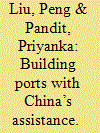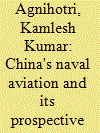| Srl | Item |
| 1 |
ID:
162740


|
|
|
|
|
| Summary/Abstract |
China’s port development projects at home and abroad has generated much discussion among the scholars and policymakers. Since 5 of the top 10 container ports in the world are in mainland China and its shipping companies carry more cargo than those of any other nation, it points to the port efficiency and maritime infrastructure that China has developed in the recent years. However, some of China’s port development activities abroad have been subject of controversy pertaining to its intentions around these projects. In this backdrop, the paper seeks to analyse China’s port development initiatives from littoral countries’ perspective, given their critical dependence on ports such that the level of port efficiency affects the economic growth of the region. The study takes Bangladesh’s port development projects as an example to indicate the opportunities and challenges involved in such initiatives and the need to continue with port development program in a win-win cooperative framework.
|
|
|
|
|
|
|
|
|
|
|
|
|
|
|
|
| 2 |
ID:
102856


|
|
|
|
|
| Publication |
2011.
|
| Summary/Abstract |
The PLA Navy's aviation branch, officially known as the PLA Navy Air Force (PLAN AF), comprises 25,000 personnel and more than 800 aircraft. It provides the PLA Navy with its own air capability independent of the PLA Air Force. But the Force remains largely land-based. However, the much speculated upon aircraft carrier program will impart a new dimension to the Chinese naval aviation. With the current level of national technological capability and available maritime infrastructure, the PLA Navy will, at best, be able to project power with its carriers within the South and East China Sea only, in the 2020 timeframe. It will find it increasingly hard to project power-using aircraft carriers in the Indian Ocean Region without full-fledged military bases to support logistics and ship and aircraft maintenance/repairs. Thus the credible Chinese power projection capability in the Indian Ocean still appears to be at least two decades away. But the international community must take due cognizance of this inevitability now and commence preparations to face this forthcoming challenge.
|
|
|
|
|
|
|
|
|
|
|
|
|
|
|
|
| 3 |
ID:
133522


|
|
|
|
|
| Publication |
2014.
|
| Summary/Abstract |
The paper seeks to assess the growing strategic importance of the Bay of Bengal and how this signifies for Bangladesh's imperative to develop strong maritime capabilities. With the growing significance of the Bay of Bengal, both the littoral and the extra-littoral countries are reassessing their interests in this region and reformulating respective strategies to ensure optimum benefit in their favour. After the verdict by the International Tribunal for the Law of the Sea (ITLOS) in March 2012, Bangladesh is now able to establish its claim over a significant area in the Bay of Bengal. These emerging realities are driving Bangladesh to develop capabilities to project effective control over its maritime zone and to ensure sustainable utilisation of marine resources. To respond efficiently, Bangladesh government has undertaken various initiatives including modernisation of the Bangladesh Navy with an aim of establishing a three dimensional force. The paper, based on secondary literature, finds that there is a growing interest among the countries in the Bay of Bengal area leading to a competitive strategic atmosphere for countries like Bangladesh. The findings also suggest that Bangladesh's drive for maritime capability building is a timely and pragmatic step which requires further strengthening in the coming years. Besides, the paper also argues that Bangladesh needs to formulate a comprehensive maritime strategy, focusing on diverse sectors of capability building. Some key areas can include empowering the coast guard, resource exploration and exploitation capacities, maritime infrastructure development for connectivity and seaborne trade as well as well-coordinated maritime governance.
|
|
|
|
|
|
|
|
|
|
|
|
|
|
|
|